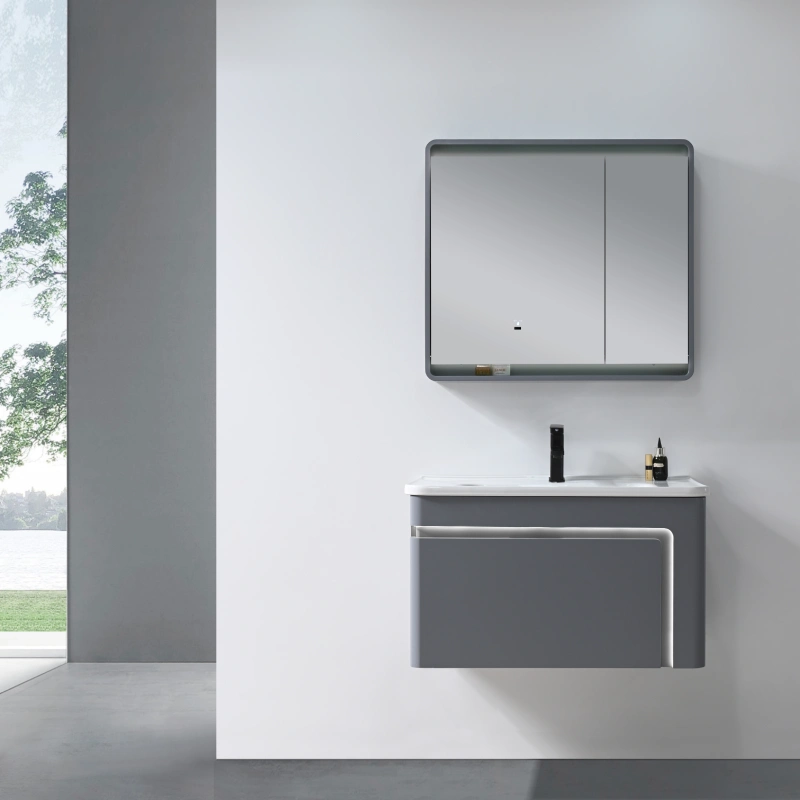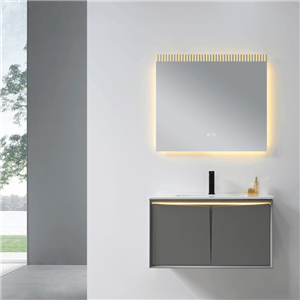How to Customize a Bathroom Vanity: The Ultimate Guide
Table of Contents:
Composition of a Bathroom Vanity
1.1 Main Cabinet
1.2 Countertop
1.3 Sink
1.4 Side Cabinet
1.5 Mirror/Mirror Cabinet
1.6 Shelves & Accessories
Choosing the Right Bathroom Vanity Manufacturer for Customization
2.1 Company Strength
2.2 Customization Options
2.3 Material Quality
2.4 Research and Development (R&D)
2.5 Production Capacity and Technology
2.6 Customer Reviews and Reputation
Step-by-Step Bathroom Vanity Customization Guide
3.1 Choosing the Main Cabinet Material
3.2 Color Customization and Surface Finish
3.3 Selecting the Sink and Countertop
3.4 Choosing Hardware and Accessories
3.5 Selecting Packaging Types
3.6 Assembly and Installation Details
Benefits of Custom Bathroom Vanities
4.1 Perfect Fit for Space
4.2 Enhancing Bathroom Aesthetics
4.3 Increasing Storage Capacity
4.4 Boosting Home Value
Common Questions About Custom Bathroom Vanities
5.1 How much does Custom Bathroom Vanities cost?
5.2 How long does it take to make Custom Bathroom Vanities?
5.3 How long is the delivery time for Custom Bathroom Vanities?
Trends in Custom Bathroom Vanities Design
6.1 Ongoing Design Trends
6.2 Innovative Materials and Techniques
Bathroom Vanity Installation and Maintenance Tips
7.1 Preparing for Installation
7.2 How to Install a Bathroom Vanity
7.3 Maintenance and Cleaning Tips
Final Thoughts and Recommendations
1. Composition of a Bathroom Vanity
Before diving into customization options, it's essential to understand the basic components that make up a bathroom vanity. Each part serves a distinct purpose, and together they form a functional and aesthetically pleasing unit.
1.1 Main Cabinet
The main cabinet is the backbone of the bathroom vanity. It provides the structural support and storage needed in the bathroom. Depending on the design, it could feature drawers, shelves, or cupboards. The material of the main cabinet should be chosen carefully, as it determines the durability, stability, and overall look of the vanity.
Functionality: The main cabinet stores toiletries, cleaning supplies, towels, and other bathroom necessities. It is crucial to have a combination of closed storage (for clutter) and open shelving (for easy access to frequently used items).
Material Choices: The material chosen for the main cabinet can significantly impact the longevity and aesthetics of the vanity. Popular materials include solid wood, plywood, MDF (Medium Density Fiberboard), and particleboard.
1.2 Countertop
The countertop is an important element in a bathroom vanity. It acts as a surface for placing the sink and offers additional space for toiletries or decorations. When customizing a bathroom vanity, the choice of countertop material plays a critical role in the overall appearance and functionality.
Common Materials: Stone (granite, marble, quartz) and engineered materials (like artificial stone) are popular for bathroom countertops due to their water resistance and aesthetic appeal.
Durability: The countertop must be durable and resistant to water and humidity. Stone materials like granite are naturally water-resistant, while engineered materials like quartz are specifically designed to handle bathroom conditions.
1.3 Sink
The sink is the focal point of any bathroom vanity. It not only serves a practical purpose but also contributes to the design and feel of the bathroom.
Types of Sinks: Sinks come in several styles, including undermount sinks (which sit below the countertop), drop-in sinks (which sit above the countertop), and vessel sinks (which are like bowls placed on top of the countertop).
Material Options: Common sink materials include ceramic, porcelain, glass, and stone. Each material has unique properties, with ceramic being durable and easy to clean, while stone offers a luxury feel.
1.4 Side Cabinet
Many custom bathroom vanities come with an additional side cabinet for extra storage. This cabinet can be mounted beside the vanity or attached as an extension.
Functionality: Side cabinets are typically used to store towels, extra toilet paper, or cleaning supplies. They help maintain a clutter-free space while keeping everyday essentials close by.
1.5 Mirror/Mirror Cabinet
The mirror is often considered a part of the vanity, especially when it is built into the design. Mirrors are crucial for both practical and aesthetic purposes in the bathroom.
Mirror Cabinet: A mirror cabinet combines the functionality of a mirror and additional storage. It often includes shelves inside the cabinet for storing medicine, toiletries, or cosmetics.
Design Considerations: Mirrors and mirror cabinets come in various shapes, sizes, and finishes, allowing for a customized fit with the vanity design.
1.6 Shelves & Accessories
Additional shelves or decorative accessories are often added to bathroom vanities for extra storage or style. These include towel racks, soap dishes, and decorative trays that help organize the vanity while enhancing the bathroom’s look.
Customization Options: Shelves can be added inside the main cabinet or mounted above the vanity. Accessories like drawer organizers, mirrors with LED lights, and decorative handles or knobs can elevate the vanity’s design.
2. Choosing the Right Bathroom Vanity Manufacturer for Customization
Finding the right manufacturer for your custom bathroom vanities is crucial to the success of your project. Here are the key factors to consider when selecting a manufacturer:
2.1 Company Strength
A strong, well-established manufacturer will ensure reliable production and timely delivery. Larger manufacturers usually have more resources, including advanced production technologies, skilled labor, and the financial stability to handle bulk orders.
Production Capacity: Ensure the manufacturer has the capacity to handle your order volume. A reliable supplier will be able to scale up production without compromising on quality.
2.2 Customization Options
Not all manufacturers offer the same level of customization. Some may offer limited choices, while others provide a wide range of options for materials, finishes, sizes, and features.
Design Flexibility: A good manufacturer will allow you to tailor each aspect of the vanity, from the cabinet design to the hardware and finish, so it fits your unique style.
2.3 Material Quality
Ensure that the manufacturer uses high-quality materials. The durability of your vanity depends on the materials chosen, so select a manufacturer that uses reliable and durable components like water-resistant wood, high-quality marble, or scratch-resistant finishes.
2.4 Research and Development (R&D)
Manufacturers with a strong R&D team are more likely to offer innovative solutions and adapt to current trends. Look for manufacturers that are constantly innovating their designs to meet customer needs.
Latest Trends: Manufacturers with R&D capabilities can also help you stay up-to-date with the latest design trends, ensuring your Custom Bathroom Vanities have a modern and stylish appeal.
2.5 Production Technology
Advanced production techniques ensure that the vanities are made to precise specifications. Modern technologies such as CNC (Computer Numerical Control) machinery provide accuracy in cutting and shaping materials, while advanced finishing techniques ensure smooth, durable surfaces.
Quality Control: A manufacturer that employs advanced production technology is more likely to have stringent quality control processes in place, ensuring the final product meets your expectations.
2.6 Customer Reviews and Reputation
Before selecting a manufacturer, research their reputation. Look for online reviews, customer testimonials, or industry certifications that verify the quality of their products and services. Word-of-mouth recommendations can also be valuable when choosing a manufacturer.
Transparency: Choose a manufacturer that is transparent about their processes, pricing, and timelines. A trustworthy supplier will provide clear contracts and keep you updated throughout the process.
3. Step-by-Step Bathroom Vanity Customization Guide
Now that you understand the components of a bathroom vanity and how to choose the right manufacturer, let's walk through the process of customizing your bathroom vanity.
3.1 Choosing the Main Cabinet Material
The first step in customization is selecting the material for the main cabinet. Here are some options:
Solid Wood: Provides a classic, durable look, but may warp over time in humid environments unless properly treated.
Plywood: Highly durable and less susceptible to water damage compared to solid wood.
MDF: Offers a smooth finish and is cost-effective, but can be prone to moisture damage over time.
Particleboard: Least expensive but less durable; best for low-budget projects.
3.2 Color Customization and Surface Finish
Once you've selected the material, it's time to decide on color and finish. Color can dramatically alter the overall aesthetic of your bathroom vanity. Common finishes include:
Paint: Ideal for achieving a sleek, modern look. Choose oil-based or latex paints for durability.
Veneer: Thin layers of real wood glued to MDF or plywood. It offers a natural wood finish without the cost of solid wood.
Laminate: Durable and easy to clean, laminate comes in many colors and patterns, providing a variety of design options.
3.3 Selecting the Sink and Countertop
Sink Style: Choose between undermount, drop-in, or vessel sinks depending on your design preferences and budget.
Countertop Material: Choose from options like quartz, granite, marble, or engineered stone. Each has unique benefits, but quartz is often chosen for its non-porous nature and low maintenance.
3.4 Choosing Hardware and Accessories
Customizing hardware is a crucial part of the design process. The knobs, handles, and faucets you select can dramatically change the style and functionality of your vanity.
Hardware Style: Whether you prefer modern sleek handles, vintage knobs, or something entirely custom-made, ensure the hardware complements the overall style of your bathroom.
3.5 Selecting Packaging Types
For larger custom projects, the packaging of your bathroom vanity can affect delivery and installation. Ask your manufacturer to ensure that all components are securely packaged to avoid damage during shipping.
3.6 Assembly and Installation Details
Once your vanity is delivered, you'll need to install it. Some manufacturers offer assembly and installation services, while others may leave it to you or a contractor.
4. Benefits of Custom Bathroom Vanities
Why should you opt for Custom Bathroom Vanities instead of buying a pre-made one? Here are some of the top benefits:
4.1 Perfect Fit for Space
Custom Bathroom Vanities ensure a perfect fit for your bathroom, whether you have a small, narrow space or a large, luxurious bathroom. Unlike pre-made vanities, custom options allow you to fully utilize every inch of available space.
4.2 Enhancing Bathroom Aesthetics
Custom Bathroom Vanities give you the opportunity to create a vanity that matches your personal taste and enhances the overall style of your bathroom. Whether you prefer a contemporary look, a traditional feel, or a modern spa vibe, custom vanities offer endless design possibilities.
4.3 Increasing Storage Capacity
Custom Bathroom Vanities can be designed to offer optimal storage solutions. From built-in drawer organizers to deep shelves, a custom design ensures that your vanity meets both functional and aesthetic needs.
4.4 Boosting Home Value
A custom vanity is a high-quality feature that can add value to your home, especially if you're planning to sell. A well-designed, functional bathroom vanity enhances the overall appeal of the bathroom.
5. Common Questions About Custom Bathroom Vanities
Here are some frequently asked questions that may help clarify your doubts before diving into the customization process:
5.1 How Much Do Custom Bathroom Vanities Cost?
The cost of Custom Bathroom Vanities varies greatly depending on materials, size, design, and brand. Generally, Custom Bathroom Vanities range from $500 to $5,000 or more, depending on the complexity.
5.2 How Long Does it Take to Make a Custom Bathroom Vanities?
Production time forCustom Bathroom Vanities can range from a few weeks to a couple of months. The timeline depends on the complexity of the design and the manufacturer's production capabilities.
5.3 How Long is the Delivery Time for Custom Bathroom Vanities?
Delivery time also varies based on the manufacturer and your location. On average, Custom Bathroom Vanities may take anywhere from 2 to 6 weeks to arrive after production.
6. Trends in Custom Bathroom Vanity Design
Bathroom vanity designs evolve with changing trends. Here’s a look at some of the latest innovations:
6.1 Ongoing Design Trends
Modern bathrooms are moving toward minimalist designs with clean lines and functional spaces. Neutral colors, open shelving, and integrated lighting are gaining popularity.
6.2 Innovative Materials and Techniques
New materials like recycled glass, eco-friendly wood finishes, and sustainable quartz are becoming more popular. These materials not only look great but also contribute to a more environmentally conscious bathroom.
7. Bathroom Vanity Installation and Maintenance Tips
To ensure your bathroom vanity lasts, it’s important to install it correctly and maintain it properly.
7.1 Preparing for Installation
Before installation, clear the area and measure the space to ensure a perfect fit. It’s always a good idea to hire a professional installer if you’re unsure about installation.
7.2 How to Install a Bathroom Vanity
Installation typically involves securing the vanity to the wall and connecting the plumbing. Make sure to follow all manufacturer instructions carefully for the best results.
7.3 Maintenance and Cleaning Tips
Regular cleaning with mild soap and water can keep your vanity looking new. For stone countertops, use a non-abrasive cleaner to avoid scratches. Check plumbing connections regularly for leaks.
8. Final Thoughts and Recommendations
Customizing your bathroom vanity can transform the look and feel of your bathroom. By carefully selecting materials, working with a reliable manufacturer, and following proper installation and maintenance procedures, you can ensure a long-lasting, stylish addition to your home.





